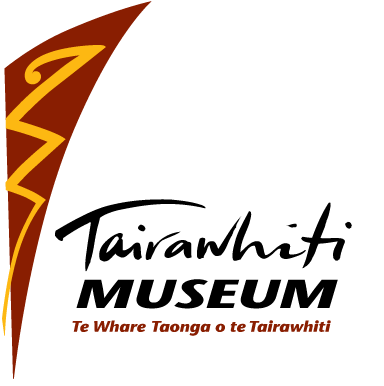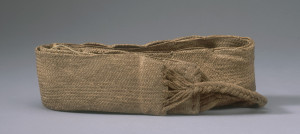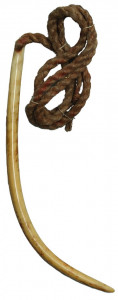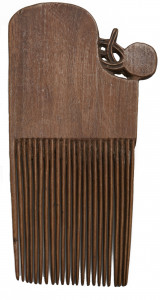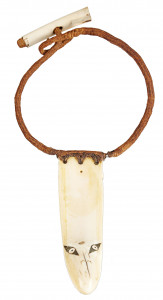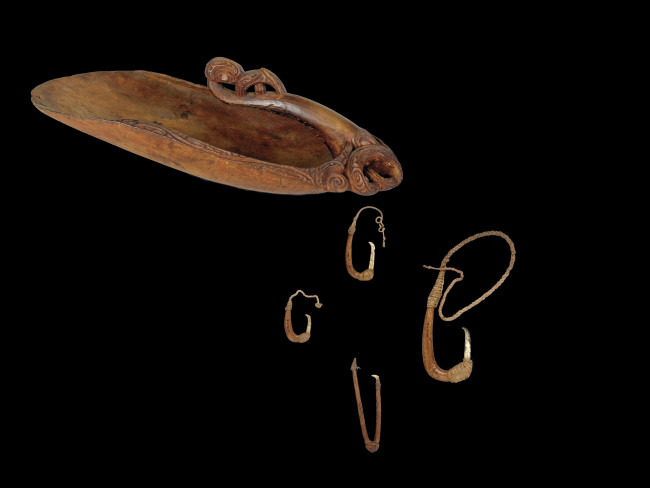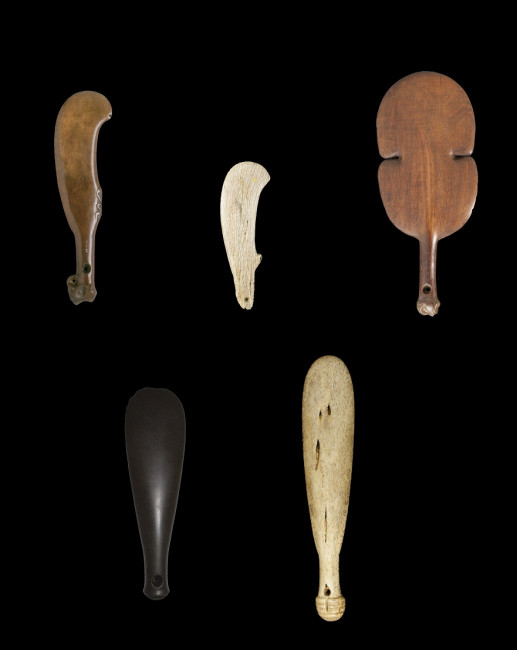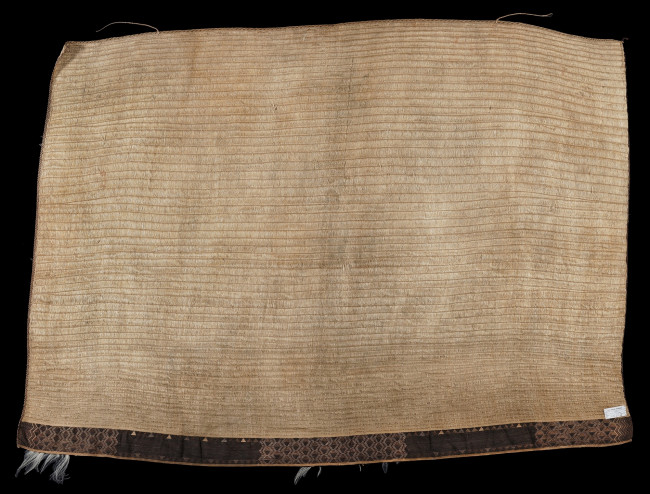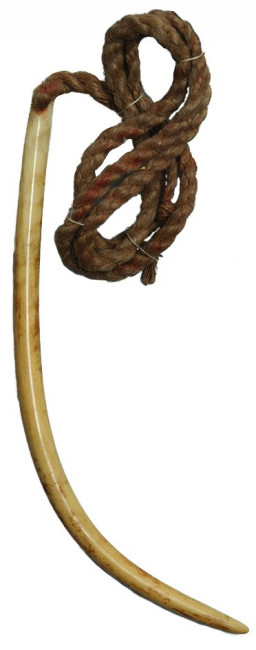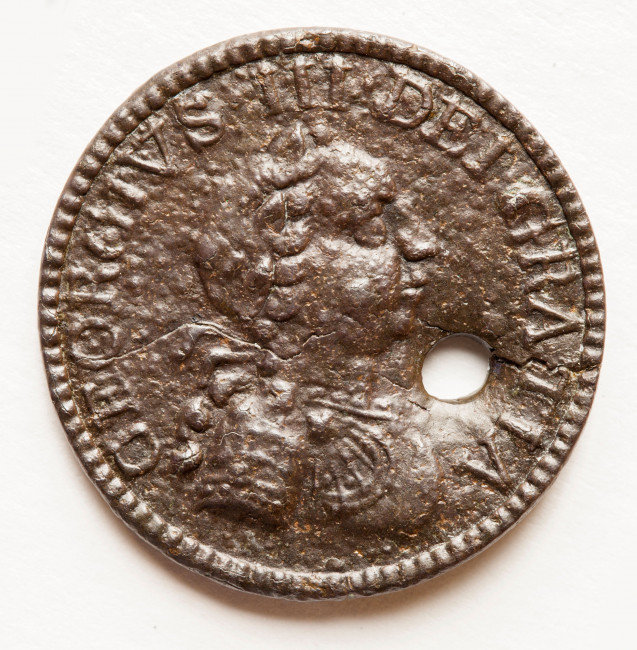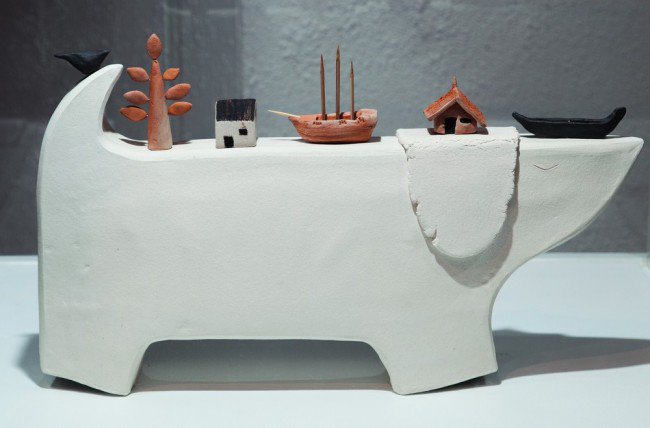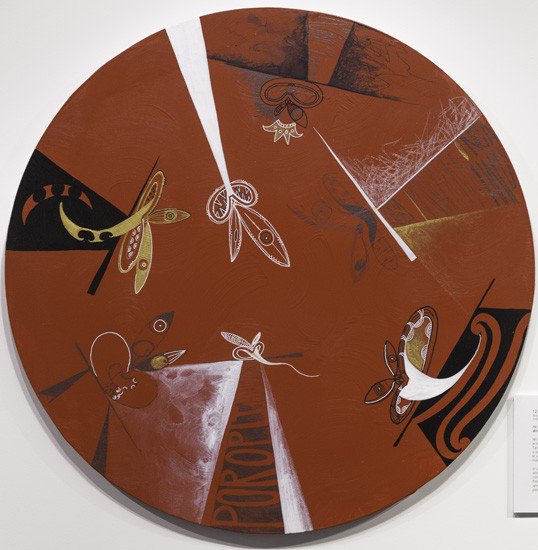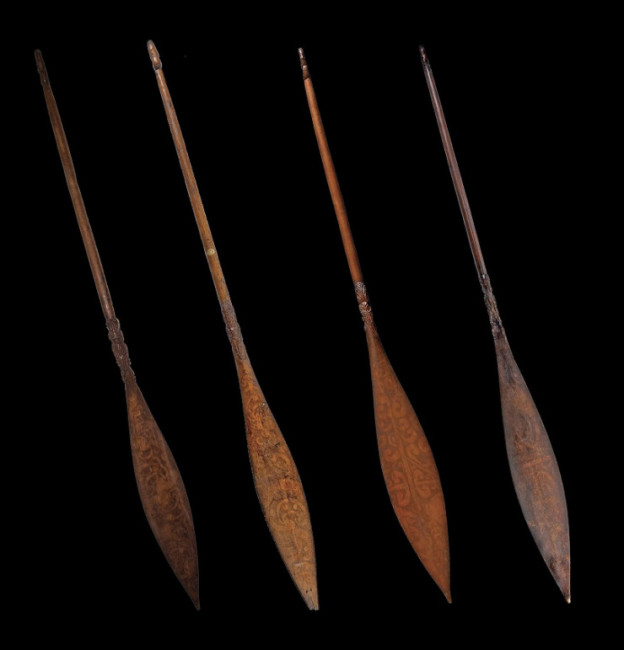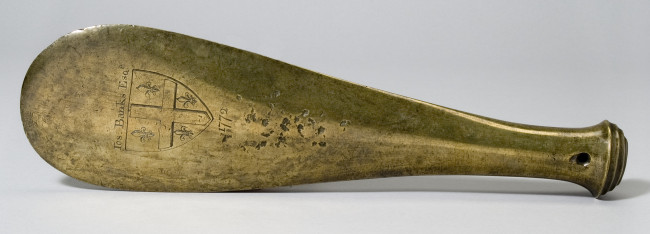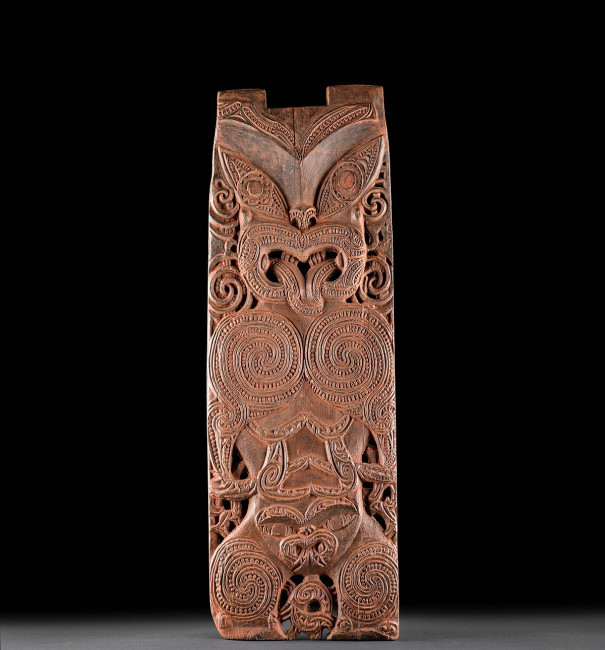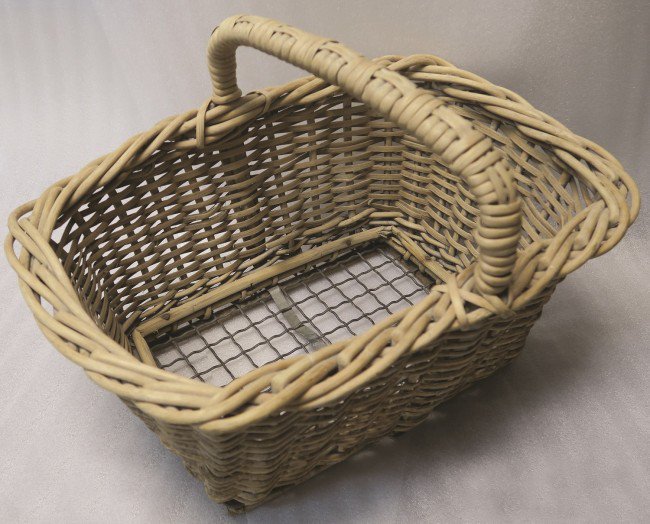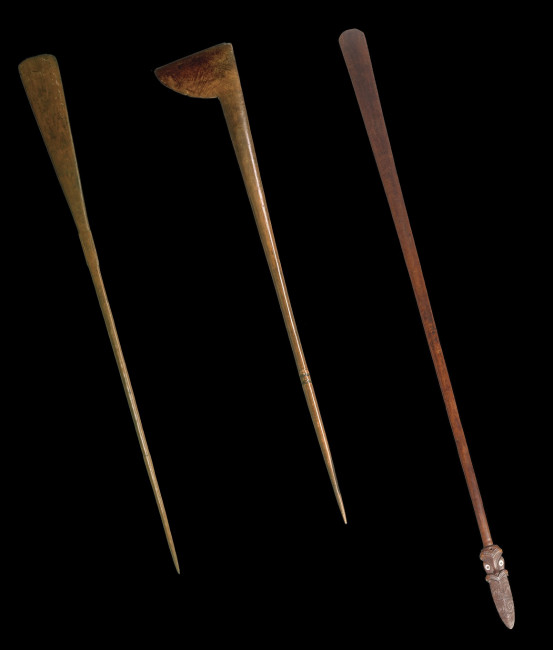Whai ā-matawā nei, tīmata i runga i te taha mauī
Tātua belt
Harakeke Flax
He mea hanga tēnei tātua ki ngā whenu harakeke. Waihangatia me kore ake he whāriki, engari tēnei ka pōkai kē kia mātotoru ai te tātua, hei papare i te riri pakipaki. Whakamaua ai ētahi taura muka harakeke hei taura here ki ia taha. He kākahu tēnei e mau ai te kairākau ki te pakanga, hei tātāwhi patu. He mukunga kōkōwai e mau ana ki tēnei tātua, he tohu nā te mata kai kutu.
This tātua is made of flax strips known as whenu. They were woven in the same way as large floor mats (whāriki) and were then folded, creating a thick, protective tātua. A series of plaited flax fibres were attached and joined to make one complete tying cord at both ends. Tātua were traditionally worn in battle to secure items such as patu. This tātua has traces of the kōkōwai (burn red ochre and shark’s oil) markings which rubbed off the original wearer.
On loan from Cambridge Museum of Archaeology and Anthropology, D1914.47
Aurei cloak pin
Rei-puta, muka harakeke Whalebone-tooth, flax fibre
Whakamahia ai tēnei taonga te aurei hei whakamau i ngā pūeru ō te Māori. Kei roto i tana ingoa tōna whakamahukitanga, he au-tui, he mea hanga ki te rei-puta. Nāwai, kua noho hei ingoa karanga ki ēnei tū hanga taonga ō te Māori.
Aurei were used to fasten traditional cloaks over the shoulder. The word au comes from the Māori term for the thatch needle and rei refers to the whale ivory from which some of them were made. Au-rei has come to be a general term for all ornaments of this type.
On loan from Cambridge Museum of Archaeology and Anthropology, D1914.4
Heru Comb
Rākau Wood
He taonga i whakamaua e te tāne hei whakaū i te pūtiki o ōna makawe. Inā rā, ko te mau heru me ngā raukura, he tohu rangatira. He mahi nā te ringarehe, te hangariki hoki o tēnei heru, kua hangā ki te rākau, e rua tekau mā toru ōna niho, ā, he mea tātai ki te manaia. E hanga taurite ana tēnei ki tērā i tāngia ai ki te waituhi rongonui ā Sydney Parkinson, te tohunga toi i haere tahi mai me Kuki.
Heru were traditionally used by men to fasten their long hair up into a topknot known as pūtiki. The heru together with bird feathers indicated the rank of the wearer. This heru is particularly small and is made of wood. It would have taken considerable technical skill to carve the twenty-three teeth. It is adorned with the carved head (manaia), similar to the heru depicted in a well-known sketch by Sydney Parkinson, the artist who accompanied Cook on his first voyage.
On loan from Cambridge Museum of Archaeology and Anthropology, D1914.38
Poro-toroa Albatross toggle
Poroiwi toroa, muka harakeke Albatross bone, flax fibre
He poro-toroa tēnei, kua whakamaua ki te taura muka harakeke hei whakamau i tētahi tāhei. Ahakoa kua kīia he poro-toroa, arā noa atu anō pea ōna kawenga.
Toggles were known as poro. This example is a poro-toroa as it is made from albatross (toroa) bone. Although this taonga has been tentatively identified as a toggle, it could have served other purposes.
On loan from Cambridge Museum of Archaeology and Anthropology, D1914.45
Rei-puta whale-tooth necklace
Reiputa, muka harakeke, poroiwi toroa
Whale-tooth, flax fibre, albatross bone
He taonga whakakai tēnei kua tautaratia ki te taura tarapī rirerire, he mea whakamaua ki te poro-toroa. He mea onge-kura, he tino taonga ki te Māori, inā hoki nō tai, nō uta, nō te manu rererangi. E taurite ana tēnei rei-puta ki tērā i oti i a Sydney Parkinson te tātai ki tana waituhinga, he kaingārahu e mau ana i ngā pūeru pakanga me ngā taonga rangatira.
This large rei-puta (neck pendant) is made from a sperm whale tooth, a rare and precious material in traditional Māori society. It is still complete with the finely woven cylinder-like taura (flax neck cord) and poro-toroa (albatross toggle). A very similar rei-puta appears in Sydney Parkinson’s portrait of a Māori chief, dressed prepared for war and adorned with noble taonga.
On loan from Great North Museum Hancock, C765
Kapeu ear pendant
Pounamu, aute Greenstone, aute bark
He huhua ngā taonga mau taringa o te Māori, pēnei i tēnei kapeu. He pounamu kua whakapīataatahia, he pikonga hei tōna pito, kua kīia hoki he tautau. Nāwai i ātaahua, kātahi ka ātaahua kē atu i te weu aute kua tautaratia ki tēnei taonga kapeu. He mea kite anō e Kuki tēnei taonga te weu aute e mau ana i ngā taringa ō te Māori.
Māori had a wide assortment of ear pendants. This type, known as a kapeu or a tautau, is a long polished drop of pounamu with a curve at the end. This beautiful kapeu pendant has a piece of aute (paper mulberry) attached. Cook also reported seeing short pieces of rolled aute worn through the ear-lobe.
On loan from Cambridge Museum of Archaeology and Anthropology, D1914.39
Tū te Whaihanga Showcase 3
Tīheru/Tata bailer Matau fishhook
Tū te Whaihanga Showcase 2
Patu ōnewa weapon Wahaika weapon Patu Parāoa weapon Kotiate weapon
Tū te Whaihanga Showcase 6
Kaitaka cloak
Aurei
Aurei cloak pin Rei-puta, muka harakeke Whalebone-tooth, flax fibre
Tū te Whaihanga Showcase 8
Mētara Koroneihana a Hōri III George III Coronation medalet
Weight on the back of Te Kuri a Paoa by Peggy Ericson
The museum is offered many interesting items for the collection over the course of the year. Often they are seemingly ordinary, everyday objects, but what makes each of them special and worthy of collecting is the wonderful stories they can tell us about our region’s history. This wicker basket is certainly one such object. This basket was used by William Hamilton (known as Ham) Hannah (b. 1920, d.1967) to deliver bread for Walter Findlay’s Bakery in the 1930s. Ham would have delivered bread around Gisborne by horse and cart. A few people out there may remember having bread delivered by him, perhaps using this basket! Ham served as a Driver in the Army Service Corps in the Second World War and continued to work as a driver when he returned to Gisborne after the war. In the 1960s, he was the Custodian at Churchill Park. He was married to Sarah (Sadie) and they had four children. We would like to thank Julie Hannah for gifting her father-in-law’s breadbasket to the museum.
Ham and two of his four children, Kevin (left) and Gareth (right), posing in the basket in the garden of the family’s home.
Walter Findlay’s advert, The Gisborne Herald, 20 October 1941
Hamuera by Erena Koopu
Hamuera by Erena Koopu, 2018 Acrylic and graphite on canvas, 710mm diameter This work by Erena Koopu was part of the exhibition Hei ō Mō Apanui | Iwi Sustenance held at Tairāwhiti Museum in 2018 and purchased by the Friends of Tairāwhiti Museum for the collection. He waiata a ringa (an action song) Performed by Te Kapa Haka o Te Whānau a Apanui at Te Matatini in the year 2005 in Palmerston North. Nō te tau 2004 ka whakaturehia e te kāwanatanga te pire takutai moana, e riro ai te taitara o te papa moana, tōna ritenga, he muru whenua. I taua tau rā, ko Tāriana Tūria te wahine toa o Reipa kāore i tautokona taua pire, ā, ko ētahi atu o ana hoa mema Māori, i tautoko tonu. He waiata-ā-ringa tēnei e kōrero ana ki aua mema rā, kia aro ki ngā tohutohu a ngā poropiti Māori, kei reira te māramatanga e noho ana. In 2004 the Government passed the controversial Foreshore and Seabed Bill, which transferred title to the crown, and in itself is a form of modern day confiscation. In that same year, Tāriana Tūria, Māori MP of Labour crossed the floor, while the rest of her Māori colleagues remained seated. This action song speaks to those seated members, and urges them to remember the lessons of past Māori prophets, as clarity must resides in their messages.
Tū te Whaihanga Showcase 5 and 7
Hoe paddles
Tū te Whaihanga Showcase 13
Patu Parāhe Brass patu
Tū te Whaihanga Showcase 12
Te Pou o Hinematioro
Ham Hannah’s Breadbasket
The museum is offered many interesting items for the collection over the course of the year. Often they are seemingly ordinary, everyday objects, but what makes each of them special and worthy of collecting is the wonderful stories they can tell us about our region’s history. This wicker basket is certainly one such object. This basket was used by William Hamilton (known as Ham) Hannah (b. 1920, d.1967) to deliver bread for Walter Findlay’s Bakery in the 1930s. Ham would have delivered bread around Gisborne by horse and cart. A few people out there may remember having bread delivered by him, perhaps using this basket! Ham served as a Driver in the Army Service Corps in the Second World War and continued to work as a driver when he returned to Gisborne after the war. In the 1960s, he was the Custodian at Churchill Park. He was married to Sarah (Sadie) and they had four children. We would like to thank Julie Hannah for gifting her father-in-law’s breadbasket to the museum.
Ham and two of his four children, Kevin (left) and Gareth (right), posing in the basket in the garden of the family’s home.
Walter Findlay’s advert, The Gisborne Herald, 20 October 1941
Tū te Whaihanga Showcase 1
Pouwhenua weapon Tewhatewha weapon Taiaha weapon
The museum’s collections are always growing and on this page we share some of the highlights. Our thanks to the donors for their support.
Donating to the collection
Visit our Donations page for more information.
Research and access
Researchers can view collections that are not on display by making an appointment with the Museum Collection Manager. Staff can also take small group tours through the collection storage facilities by appointment. Please note that staff are not always available immediately and it is advisable to make arrangements as far in advance as possible, particularly if you are only visiting Gisborne for a short period.
Researchers who are unable to visit in person can make their enquiry by email, letter or telephone
